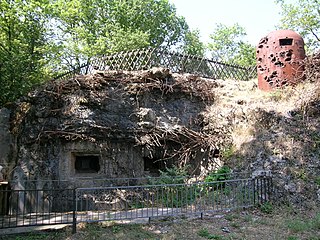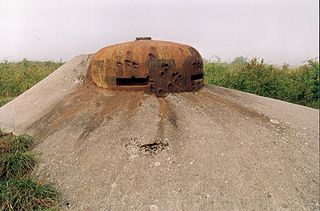Ouvrage Coucou is a lesser work of the Maginot Line, located in the Fortified Sector of Boulay. The ouvrage consists of two infantry blocks, and is located between the gros ouvrages of Hackenberg and Mont des Welches, facing Germany, just north of Kemplich.

Ouvrage Hobling is a lesser work of the Maginot Line. Located in the Fortified Sector of Boulay, the ouvrage consists of two infantry blocks and two observation blocks, and is located between gros ouvrage Michelsberg and petit ouvrage Bousse, facing Germany. It has been stripped of metals and abandoned.
Ouvrage Berenbach, also known as Ouvrage Behrenbach, is a lesser work of the Maginot Line. Located in the Fortified Sector of Boulay, the ouvrage is located between gros ouvrage Anzeling and petit ouvrage Bovenberg, facing Germany. The ouvrage consists of two infantry blocks and one observation block. Uniquely, the blocks are not connected by subterranean galleries, as is the case in virtually all other Maginot fortifications.
Ouvrage Bovenberg is a lesser work of the Maginot Line. Located in the Fortified Sector of Boulay, the ouvrage is located between petits ouvrages Berenbach and Denting, facing Germany. It consists of two infantry blocks and two artillery blocks.
Ouvrage Denting is a lesser work of the Maginot Line. Part of the Fortified Sector of Boulay, the ouvrage consists of three infantry blocks, and is located between petits ouvrages Bovenberg and Village Coume, near the village of Denting in Moselle département, facing Germany. The position saw little action in World War II.
Ouvrage Village Coume is a lesser work of the Maginot Line. Located in the Fortified Sector of Boulay, the ouvrage consists of three infantry blocks, and is located between petits ouvrages Bovenberg and Coume Annexe Nord, facing Germany. The position saw little action in World War II. It was sold in the 1970s and stripped by salvagers.

Ouvrage Coume Annexe Sud is a lesser work of the Maginot Line. Located in the Fortified Sector of Boulay, the ouvrage consists of two infantry blocks, one artillery block and one observation block, and is located between petits ouvrages Coume and Mottemberg, facing Germany.
Ouvrage Mottenberg is a lesser work of the Maginot Line. Part of the Fortified Sector of Boulay, the ouvrage consists of one entrance block and two infantry blocks, and is located between petits ouvrages Coume Annexe Sud and Kerfent, facing Germany.

Ouvrage Bambesch is a lesser work of the Maginot Line. Located in the Fortified Sector of Faulquemont, the ouvrage consists of three infantry blocks, and is located between petits ouvrages Kerfent and Einseling, facing Germany. Completed in 1932, it is located in the Bois de Bambesch. On 20 June 1940 during the Battle of France, Bambesch was attacked by German forces, whose artillery battered the position, which could not be effectively supported by its neighbors, into surrender. Since 1973, Bambesch has been operated as a museum and is open to the public.

Ouvrage Laudrefang is a lesser work of the Maginot Line. Located in the Fortified Sector of Faulquemont, the ouvrage consists of one infantry block, and is located between petits ouvrages Einseling and Teting, facing Germany. Laudrefang was originally planned as a gros ouvrage. With a heavy armament for a petit ouvrage it successfully defended its neighbors against German attack during the Battle of France. Laudrefang is abandoned and flooded, and was heavily damaged by German bombardment in 1940.

Ouvrage Téting is a lesser work of the Maginot Line. Located in the Fortified Sector of Faulquemont, the ouvrage consists of one infantry block and two observation blocks, and is located facing Germany between petits ouvrages Laudrefang and the Saar valley, which was to be inundated in times of emergency. With artillery support from its neighbor Laudrefang, Téting held out against German bombardment during the Battle of France in 1940. It is now abandoned.
Ouvrage Mauvais-Bois is a petit ouvrage of the Fortified Sector of the Crusnes on the Maginot Line. It is located between the gros ouvrage Latiremont and the petit ouvrage Bois-du-Four, facing the Belgium/Luxembourg border. The original plan for the position was for two phases of construction, resulting in a gros ouvrage provided with heavy artillery. The increase in tension between France and Germany in the late 1930s caused resources to be diverted elsewhere, and only the first three combat blocks were built. In 1940 the ouvrage was regularly bombarded, but not directly attacked by German infantry. When the French military divested itself of the majority of the Maginot fortifications, Mauvais-Bois was the second to be sold.

The VDP cloche was an element of the Maginot Line fortifications. A cloche (bell) was a fixed and non-retractable firing position made of a thick iron casting which shielded its occupant. By comparison, turrets could be rotated and sometimes lowered so that only the top shell was exposed. VDP cloches were used for observation of the surrounding area for artillery direction. VDP is an acronym for Vision Directe et Périscopique. By comparison with the GFM cloche, the VDP cloche had narrower ports and was consequently lower in profile.

Ouvrage Haut-Poirier is a lesser work of the Maginot Line. The ouvrage consists of one entry and three infantry blocks, and is located between the Saare valley and petit ouvrage Welschhof, facing Germany. It is the only ouvrage in the Fortified Sector of the Sarre, the remainder of the area being covered by smaller blockhouses and areas of inundation. It was assaulted by German forces during the Battle of France and was captured after a seven-hour bombardment. Haut-Poirier is abandoned, although one of its satellite casemates is maintained as a museum.

Ouvrage Lembach is a petit ouvrage of the Maginot Line. Lembach is adjoined by petit ouvrage Grand Hohekirkel at some distance to its west and gros ouvrage Four-à-Chaux immediately to its east. It faces the German frontier, and was part of the Fortified Sector of the Vosges. During the Battle of France in 1940, the German 215th Infantry Division broke through the line of smaller fortifications to the west of Lembach, but did not directly attack. After aerial bombardments, Lembach surrendered with the rest of the Maginot fortifications according to the terms of the Second Armistice at Compiègne. After the war Lembach was renovated for further use, but was abandoned by the 1970s.
Ouvrage Eth is an isolated petit ouvrage of the Maginot Line, built as part of the "New Fronts" program to address shortcomings in the Line's coverage of the border with Belgium. It is located between the villages of Eth and Wargnies-le-Grand, in Nord département. Eth is the sole Maginot fortification in the Fortified Sector of the Escaut, which primarily consisted of individual casemates, blockhouses and the improved 19th-century Fort de Maulde. During the Battle of France the ouvrage resisted artillery attack for four days before the garrison evacuated through a drain to a neighboring casemate.

Ouvrage Boussois is a petit ouvrage of the Maginot Line, built as part of the "New Fronts" program to address shortcomings in the Line's coverage of the border with Belgium. Like the other three ouvrages near Maubeuge, it is built on an old Séré de Rivières fortification, near the town of Boussois. The fortification surrendered to the Germans twice, in the First World War on 6 September 1914, and in the Second World War on 22 May 1940. The site is now abandoned.
Ouvrage Vélosnes is a gros ouvrage of the Maginot Line, located in the Fortified Sector of Montmédy between the towns of Othe and Vélosnes, facing Belgium. It possesses four combat blocks and one entrance block. It is located to the east of petit ouvrage Thonnelle. The position was sabotaged and abandoned by French forces that were ordered to retreat from the exposed position in June 1940 during the Battle of France. The ouvrage is abandoned and is administered as a nature preserve.

Ouvrage Thonnelle is a petit ouvrage of the Maginot Line, located in the Fortified Sector of Montmédy between the towns of Thonnelle and Verneuil-Petit, facing Belgium. It possesses four combat blocks. It is located between gros ouvrages Vélosnes and Chesnois. The position was sabotaged and abandoned by French forces that were ordered to retreat from the exposed position in June 1940 during the Battle of France. The ouvrage is abandoned.

Ouvrage Chesnois, also known as Ouvrage Chênois, is a gros ouvrage of the Maginot Line, located in the Fortified Sector of Montmédy, facing Belgium. The ouvrage lies between the towns of Montlibert and Thonne-le-Thil. It possesses six combat blocks. It is located between gros ouvrage Thonnelle and petit ouvrage La Ferté. The position was sabotaged and abandoned by French forces that were ordered to retreat from the exposed position in June 1940 during the Battle of France. The ouvrage is now abandoned and sealed.












